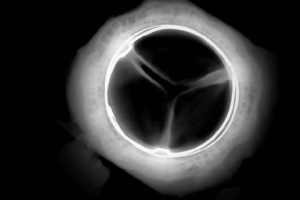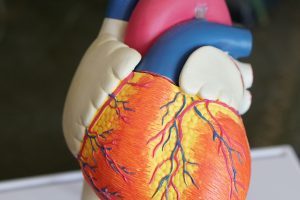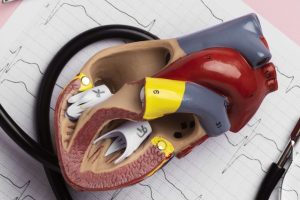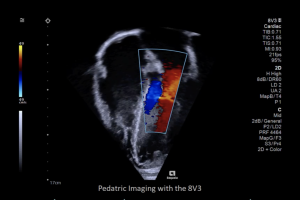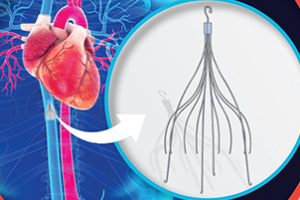The heart never takes a break. The heart is a strong muscle that never stops exercising, not for a minute. Every minute it needs blood, nourishment and oxygen. At Amarillo Heart Institute, we understand the importance of keeping your heart healthy and functioning at its best. We believe that a healthy heart is the foundation of a healthy life, and our goal is to provide you with all you need to achieve optimal heart health, a happier heart.
Valvular Heart Disease
Valvular Heart Disease refers to any condition that affects the heart valves, which are the structures that help regulate blood flow through the heart. The heart valves open and close to allow blood to flow in one direction, and they help ensure that blood is flowing efficiently through the heart and to the rest of the body.
Valvular Heart Disease can occur when the heart valves become damaged or diseased, which can lead to problems with blood flow and increased strain on the heart.

Image by Freepik
Types of Valvular Heart Disease
Valvular Heart Disease can affect any of the heart valves, which include the mitral, tricuspid, aortic, and pulmonary valves. Each of these valves has its own set of potential problems that can lead to Valvular Heart Disease.
Mitral valve disease is one of the most common forms of Valvular Heart Disease. It occurs when the valve that separates the left atrium and left ventricle doesn’t close properly, causing blood to flow backward into the atrium. This can cause shortness of breath, chest pain, and fatigue. Mitral valve disease can be caused by conditions such as rheumatic fever, congenital heart defects, and endocarditis.
Tricuspid valve disease occurs when the valve that separates the right atrium and right ventricle doesn’t close properly, causing blood to flow backward into the atrium. This can lead to symptoms such as shortness of breath, fatigue, and swelling in the legs and abdomen.
Aortic valve disease occurs when the valve that separates the left ventricle and aorta becomes narrowed or doesn’t close properly, causing blood to flow backward into the ventricle or into the aorta itself. This can cause symptoms such as chest pain, shortness of breath, and fainting.
Pulmonary valve disease is less common than other forms of Valvular Heart Disease, but can still cause significant health problems. It occurs when the valve that separates the right ventricle and pulmonary artery doesn’t open or close properly, leading to symptoms such as shortness of breath, fatigue, and chest pain.

Image by Freepik
Valvular Heart Disease can affect any of the heart valves, which include the mitral, tricuspid, aortic, and pulmonary valves. Each of these valves has its own set of potential problems that can lead to Valvular Heart Disease.
Mitral valve disease is one of the most common forms of Valvular Heart Disease. It occurs when the valve that separates the left atrium and left ventricle doesn’t close properly, causing blood to flow backward into the atrium. This can cause shortness of breath, chest pain, and fatigue. Mitral valve disease can be caused by conditions such as rheumatic fever, congenital heart defects, and endocarditis.
Tricuspid valve disease occurs when the valve that separates the right atrium and right ventricle doesn’t close properly, causing blood to flow backward into the atrium. This can lead to symptoms such as shortness of breath, fatigue, and swelling in the legs and abdomen.
Aortic valve disease occurs when the valve that separates the left ventricle and aorta becomes narrowed or doesn’t close properly, causing blood to flow backward into the ventricle or into the aorta itself. This can cause symptoms such as chest pain, shortness of breath, and fainting.
Pulmonary valve disease is less common than other forms of Valvular Heart Disease, but can still cause significant health problems. It occurs when the valve that separates the right ventricle and pulmonary artery doesn’t open or close properly, leading to symptoms such as shortness of breath, fatigue, and chest pain.

Image by Freepik
Valvular Heart Disease can occur when one of those heart valves become damaged or diseased, and depending on the nature of the valve problem, we can find:
Valve stenosis: This occurs when a valve becomes narrowed and does not open fully, which can restrict blood flow and cause the heart to work harder to pump blood.
Valve regurgitation: This occurs when a valve does not close properly and allows blood to leak back into the chamber it came from, which can also cause the heart to work harder to pump blood.
Valve prolapse: This occurs when one or more valves bulge into the chamber above or below it, which can cause the valve to leak and lead to problems with blood flow.
Here are some common types of Valvular Heart Disease::
Mitral Stenosis: This occurs when the mitral valve that separates the left atrium and left ventricle becomes narrowed, making it difficult for blood to flow from the atrium to the ventricle. This can lead to symptoms such as shortness of breath, fatigue, and chest pain. The different techniques to treat Mitral Stenosis are: Balloon Valvuloplasty and Mitral Valve Replacement.
Mitral Regurgitation: This occurs when the mitral valve does not close properly, causing blood to leak backward from the left ventricle into the left atrium. This can lead to symptoms such as fatigue, shortness of breath, and palpitations. The different techniques to treat Mitral Regurgitation are: Mitral Valve Repair and Mitral Valve Replacement.
Aortic Stenosis: This occurs when the aortic valve that separates the left ventricle and aorta becomes narrowed, making it difficult for blood to flow from the ventricle to the rest of the body. This can lead to symptoms such as chest pain, dizziness, and fainting. The different techniques to treat Aortic Stenosis are: Transcatheter Aortic Valve Replacement (TAVR) and Aortic Valve Replacement.
Aortic Regurgitation: This occurs when the aortic valve does not close properly, causing blood to leak backward from the aorta into the left ventricle. This can lead to symptoms such as fatigue, shortness of breath, and chest pain. The technique to treat Aortic Regurgitation is: Aortic Valve Replacement.
Tricuspid Regurgitation: This occurs when the tricuspid valve that separates the right atrium and right ventricle does not close properly, causing blood to leak backward into the atrium. This can lead to symptoms such as swelling in the legs and abdomen, fatigue, and shortness of breath. The technique to treat Tricuspid Regurgitation is: Tricuspid Valve Replacement.
Pulmonary Regurgitation: This occurs when the pulmonary valve that separates the right ventricle and pulmonary artery does not close properly, causing blood to leak backward into the ventricle. This can lead to symptoms such as fatigue, shortness of breath, and chest pain. The technique to treat Tricuspid Regurgitation is: Pulmonary Valve Replacement.
Valvular Heart Disease causes
Valvular Heart Disease can be caused by various factors, including:
- Aging: As we age, our heart valves can become stiff and thickened, which can lead to Valvular Heart Disease.
- Infections: Certain infections can damage the heart valves, such as endocarditis, an infection of the inner lining of the heart chambers and valves.
- Congenital defects: Some people are born with abnormal heart valves that do not function properly.
- Rheumatic fever: A complication of strep throat, rheumatic fever can cause damage to the heart valves.
- High blood pressure, high cholesterol, and diabetes can also contribute to the development of Valvular Heart Disease.
How to Diagnose Valvular Heart Disease
Valvular Heart Disease can be diagnosed using various tests and procedures, including:
Physical Examination: A healthcare provider may listen to your heart with a stethoscope to detect any abnormal heart sounds or murmurs.
Echocardiogram: This is a non-invasive test that uses ultrasound waves to produce images of the heart and its valves. It can help detect abnormalities in valve function and structure.
Electrocardiogram (ECG): This is a non-invasive test that records the electrical activity of the heart. It can help detect irregular heart rhythms and other abnormalities that may be associated with Valvular Heart Disease.
Chest X-Ray: This is a non-invasive test that produces images of the heart and lungs. It can help detect any enlargement or abnormalities in the heart.
Cardiac Catheterization: This is an invasive test that involves the insertion of a thin tube called a catheter into a blood vessel in the arm or groin and advanced to the heart. It can help detect abnormalities in valve function and structure and measure the pressure within the heart.
Once Valvular Heart Disease is diagnosed, further tests may be ordered to determine the severity of the condition and the appropriate treatment options.
It’s important to note that early detection and prompt treatment of Valvular Heart Disease can help prevent complications and improve outcomes. Therefore, regular check-ups with a healthcare provider and following recommended screening guidelines are essential
How to treat Valvular Heart Disease
Treatment for Valvular Heart Disease depends on the type and severity of the condition. In some cases, the condition may not require any treatment and can be managed with regular monitoring by a healthcare provider. However, in other cases, treatment may be necessary to alleviate symptoms, prevent complications, and improve outcomes.
Medications: Medications may be prescribed to manage symptoms associated with Valvular Heart Disease, such as high blood pressure or heart failure. These medications may include diuretics, beta-blockers, and ACE inhibitors.
Valvuloplasty: Valvuloplasty is a minimally invasive procedure that involves the insertion of a catheter with a balloon at the end through a blood vessel in the groin and advanced to the heart. Once the catheter is in place, the balloon is inflated to widen the narrowed valve.
Valve Replacement Surgery: Valve replacement surgery may be necessary if the valve is severely damaged or narrowed. During this procedure, the damaged valve is removed and replaced with a mechanical or biological valve.
Transcatheter Aortic Valve Replacement (TAVR): TAVR is a minimally invasive procedure used to treat severe aortic stenosis. During this procedure, a catheter is inserted through a blood vessel in the groin and advanced to the heart. Once in place, a new valve is implanted inside the damaged valve using the catheter.
Mitral Valve Repair: Mitral Valve Repair is a surgical procedure used to treat mitral valve regurgitation. During this procedure, the damaged valve is repaired instead of being replaced. This can be done through various techniques, such as annuloplasty or chordoplasty.
It’s important to note that treatment for Valvular Heart Disease is highly individualized and should be determined by a healthcare provider based on the patient’s specific condition and needs. Regular monitoring and follow-up care are also essential to ensure optimal outcomes.
How to prevent Valvular Heart Disease
While some types of Valvular Heart Disease cannot be prevented, there are steps you can take to reduce your risk of developing Valvular Heart Disease or delay its progression:
- Practice Healthy Habits: Maintain a healthy weight, eat a balanced diet, exercise regularly, avoid smoking, and limit alcohol consumption. These lifestyle changes can help reduce your risk of developing heart disease and other conditions that may contribute to Valvular Heart Disease.
- Manage Chronic Conditions: Manage chronic conditions such as high blood pressure, high cholesterol, and diabetes. These conditions can increase your risk of developing Valvular Heart Disease and other heart-related complications.
- Regular Check-Ups: Regular check-ups with a healthcare provider can help detect early signs of Valvular Heart Disease and other conditions that may contribute to its development.
- Antibiotic Prophylaxis: If you have Valvular Heart Disease or have had heart valve surgery in the past, your healthcare provider may recommend antibiotics before certain dental or medical procedures to prevent bacterial infection.
- Follow Treatment Plan: If you have been diagnosed with Valvular Heart Disease, it’s important to follow your treatment plan and attend regular follow-up appointments with your healthcare provider. This can help prevent complications and improve outcomes.
It’s important to note that not all cases of Valvular Heart Disease can be prevented. However, taking steps to maintain a healthy lifestyle, manage chronic conditions, and seek regular medical care can help reduce your risk of developing Valvular Heart Disease or delay its progression.

